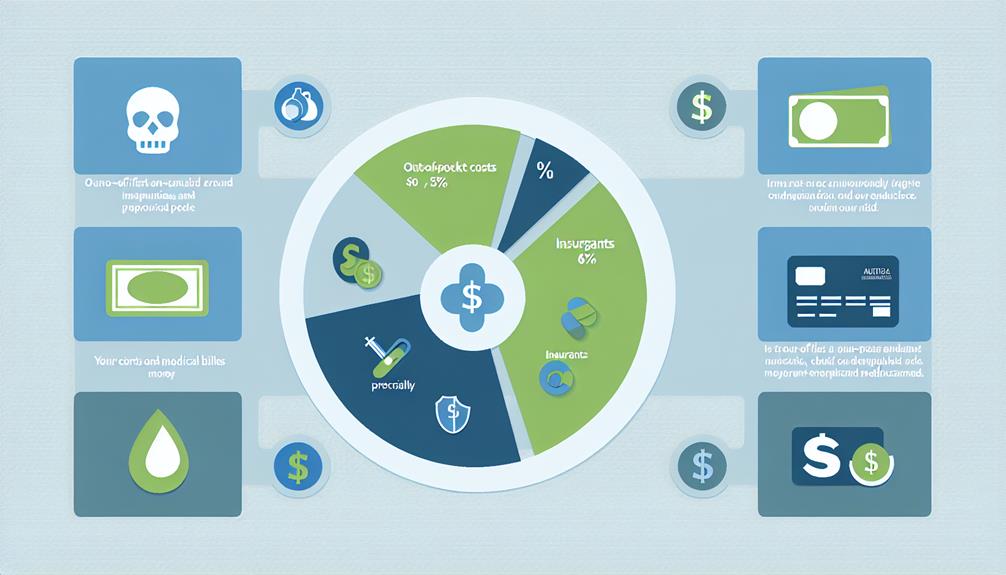Did you know that nearly 60% of adults in the U.S. live with at least one chronic illness? Steering through the world of extensive medical insurance for these conditions can be complex and often overwhelming. You might assume all plans are created equal, but the reality is that coverage can vary greatly, affecting your access to essential treatments. Understanding the nuances of each plan can make a major difference in your health and finances. So, how do you determine which plan best meets your needs?
Key Takeaways
- Comprehensive coverage for chronic illnesses is mandated under the ACA, ensuring essential health benefits without yearly or lifetime limits.
- Different health plans vary in coverage for essential services and medications; reviewing plan specifics is crucial for informed decisions.
- Out-of-pocket costs include monthly premiums, deductibles, copayments, and separate drug coverage deductibles, impacting overall healthcare expenses.
- Medicare offers robust support for chronic illnesses, covering outpatient care and prescription drugs without yearly limits, enhancing care management.
- Evaluating insurance networks is essential, as in-network providers typically reduce costs and improve access to specialized care for chronic conditions.
Health Insurance Coverage Overview
When it comes to managing health insurance coverage for chronic illnesses, it's important to break down the key elements. Most health insurance plans in the Marketplace are mandated to cover fundamental health benefits, which include care for chronic conditions like asthma and diabetes. This coverage can greatly impact your health and medical expenses, so understanding your options is critical.
Each plan's specifics can vary widely due to state regulations and individual health plan details. This variability emphasizes the significance of reviewing each plan's summary of benefits carefully. Fundamental health benefits typically cover doctor visits, lab tests, prescriptions, preventive care, and rehabilitation services for chronic conditions, ensuring you get the necessary care.
If you're considering Medicare, Part D is designed to assist with prescription drug costs for chronic conditions, guaranteeing no yearly or lifetime limits on coverage under the Affordable Care Act. It's important to understand how your selected plan covers specific medications and services, as this knowledge can greatly affect your overall healthcare costs and management options. Taking the time to explore these benefits can help you make informed choices regarding your health insurance coverage.
Variability in Plan Coverage
Variability in health insurance plan coverage can greatly impact your management of chronic illnesses. Each health plan offers different levels of coverage for essential services, medications, and treatment options. Understanding these differences is vital for effectively managing your chronic conditions.
| Plan Type | Coverage for Medications | Essential Services Included |
|---|---|---|
| Plan A | Limited drug coverage | Bariatric surgery not covered |
| Plan B | All-encompassing drug coverage | Chiropractic care included |
| Plan C | Moderate drug coverage | Bariatric surgery covered |
| Plan D | Extensive drug coverage | Chiropractic care not covered |
When evaluating your options, always refer to the summary of benefits for each plan. This document outlines the specific coverage details, including which medications are included in the drug coverage. Remember, while state regulations set minimum standards, the actual coverage can vary greatly. This variability can affect how much you'll pay out-of-pocket for medical care related to your chronic illnesses. Make sure to compare plans carefully to find one that aligns with your needs and offers adequate support for your health.
Out-of-Pocket Costs Explained

Understanding out-of-pocket costs is crucial for managing your healthcare expenses, especially if you have chronic conditions. With the Affordable Care Act (ACA) in place, all health insurance plans, except grandfathered ones, must adhere to set out-of-pocket maximums—$8,700 for individuals and $17,400 for families in 2022. This means you won't pay more than these amounts in a year for covered services.
Your monthly premium is just the beginning. You'll also face deductibles, copayments, and possibly coinsurance, which can add up quickly. Deductibles are amounts you must pay before your insurance kicks in, often varying by plan. Copayments, which are fixed fees for services like doctor visits, can also vary greatly, impacting your total medical bills.
If your health insurance plan has a separate deductible for drug coverage, this could further increase your out-of-pocket costs for medications. It's crucial to evaluate all these factors when assessing your plan. By understanding these components, you can make informed decisions that help you manage your healthcare expenses more effectively, especially when dealing with the ongoing costs associated with chronic illness.
Prescription Drug Coverage Insights
Maneuvering prescription drug coverage can considerably impact your healthcare finances, especially if you're managing chronic illnesses. Understanding how your health plan will pay for medications is essential. Different plans cover drugs in various ways, often with separate deductibles for prescriptions that can add to your out-of-pocket costs.
To effectively manage these expenses, consider the following:
- Review the drug formulary: Check if your necessary medications are covered and at what tier, as this can influence the amount you pay.
- Choose generics when possible: Generic medications typically cost less than brand-name options, helping to lower your expenses.
- Understand copayments and limits: Familiarize yourself with potential copayment amounts and coverage limits to plan your budget accordingly.
Medicare and Chronic Conditions

When you're managing a chronic condition, Medicare can be an essential resource that provides important support for your healthcare needs. Under the Affordable Care Act (ACA), there's no yearly or lifetime limit on coverage for chronic diseases, ensuring you receive ongoing treatment and management. Medicare Part B covers outpatient care, preventive services, and necessary medical equipment, making it easier for you to stay on top of your chronic care.
Medicare Part D greatly helps with medication management, assisting you with prescription drug costs, especially in the donut hole, which starts after $4,430 in covered drug spending. This can alleviate some of the financial burden that often comes with managing chronic conditions.
Additionally, coordinated care plans allow you to access urgent care services 24/7, ensuring you have the support you need in complex health situations. Working closely with your primary care physician can help you navigate your coverage and make the most of your Medicare benefits. By taking advantage of these resources, you can focus on managing your health effectively and improving your overall quality of life.
Alternative Health Plans
Alternative health plans can seem appealing, but they often fall short for those managing chronic illnesses. While these plans may offer lower premiums, the limited benefits can lead to significant out-of-pocket costs when you need care the most.
Consider these points before opting for alternative health plans:
- Limited Benefits: Many plans, like short-term health or accident-specific coverage, don't provide the extensive insurance needed for ongoing treatment of chronic conditions.
- Preexisting Conditions: Health care sharing ministries often exclude coverage for preexisting conditions, leaving you vulnerable if your illness requires frequent medical attention.
- Additional Costs: Subscription health plans may promise personalized care, but they often require extra payments for services that aren't covered, potentially increasing your overall medical expenses.
When managing chronic illnesses, it's essential to carefully evaluate any alternative health plan. The risks associated with inadequate coverage can lead to financial strain and unmet healthcare needs. Instead, look for extensive options that align with your long-term health requirements, ensuring you're protected and supported throughout your treatment journey.
Evaluating Insurance Networks

Choosing the right insurance network can greatly impact your healthcare experience, especially if you're managing a chronic illness. Evaluating insurance networks is essential since each plan has a specific list of in-network care providers, which typically offer lower out-of-pocket costs compared to out-of-network services.
| Plan Type | Access to Specialized Care | Out-of-Pocket Maximum |
|---|---|---|
| Preferred Provider Organization (PPO) | Easy access, no referrals needed | Higher out-of-pocket maximums |
| Health Maintenance Organization (HMO) | Requires referrals for specialists | Lower out-of-pocket maximums |
| Network Size | Larger networks improve access | Smaller networks may limit options |
| Provider Quality | Higher quality providers available | Varies by network |
You'll want to take into account that out-of-network care may not be covered at all under certain plans, emphasizing the importance of checking provider availability before enrollment. The size and quality of the network can greatly influence care access, especially for those with chronic conditions requiring multiple specialists. Additionally, an out-of-pocket maximum indicates the highest annual expense for in-network care, providing a financial safety net while managing your health.
Managing Costs With Chronic Care
Managing costs associated with chronic care can feel overwhelming, but understanding your insurance options makes a considerable difference. To effectively manage costs, consider the following key aspects of your plan:
- Out-of-pocket maximums: For 2022, these are capped at $8,700 for individuals and $17,400 for families, limiting your annual medical expenses.
- Additional benefits: Many plans cover chronic conditions and offer caps on medication costs, which can notably reduce your overall treatment expenses.
- Health Savings Accounts (HSAs): Utilize HSAs to cover out-of-pocket medical expenses related to chronic care. These accounts allow funds to roll over year-to-year, giving you personal control over healthcare spending.
Under the Affordable Care Act (ACA), chronic care management programs are part of essential health benefits. This means there are no yearly or lifetime limits on coverage for chronic conditions, aiding in your long-term financial planning. Additionally, understanding the varying copayment amounts for different services within your chosen plan is vital. By steering through these options carefully, you can effectively manage costs and guarantee you receive the care you need without breaking the bank.
Frequently Asked Questions
Does Health Insurance Cover Chronic Illness?
Yes, most health insurance plans cover chronic illnesses, ensuring you get the necessary care. You can expect coverage for doctor visits, lab tests, and prescription medications. Preventive care and rehabilitation services are also typically included. While specifics can vary by plan and state, the Affordable Care Act mandates essential health benefits for chronic conditions, so you won't face annual or lifetime limits on your coverage. Always check your plan details for exact benefits.
Is HMO or PPO Better for Chronic Illness?
Choosing between HMO and PPO plans can feel like deciding between a rock and a hard place! If you need coordinated care and lower costs, an HMO might be your best bet. However, if you crave flexibility and want to see specialists without a hassle, a PPO's your ticket. Consider how often you'll need specialist visits and how important cost is for you. Ultimately, it depends on what fits your health needs best.
What Insurance Provides Coverage for a Long Illness?
When you're looking for insurance that covers a long illness, you'll want to contemplate plans that include essential health benefits. Many options, like those in the Marketplace, can help with long-term conditions. Medicare Part B is another choice, covering necessary services and medications for chronic issues. Just remember, each plan's specifics can vary, so you should always review the summary of benefits to understand what's included and what's not.
What Does a Comprehensive Major Medical Health Insurance Policy Include?
A thorough major medical health insurance policy includes essential health benefits mandated by the Affordable Care Act. You can expect coverage for doctor visits, lab tests, prescription medications, preventive care, and rehabilitation services. Most plans also set an annual out-of-pocket maximum, so you won't pay more than a specified amount each year. Additionally, prescription drug coverage often features tiered pricing, ensuring you get the medications you need for your health.
